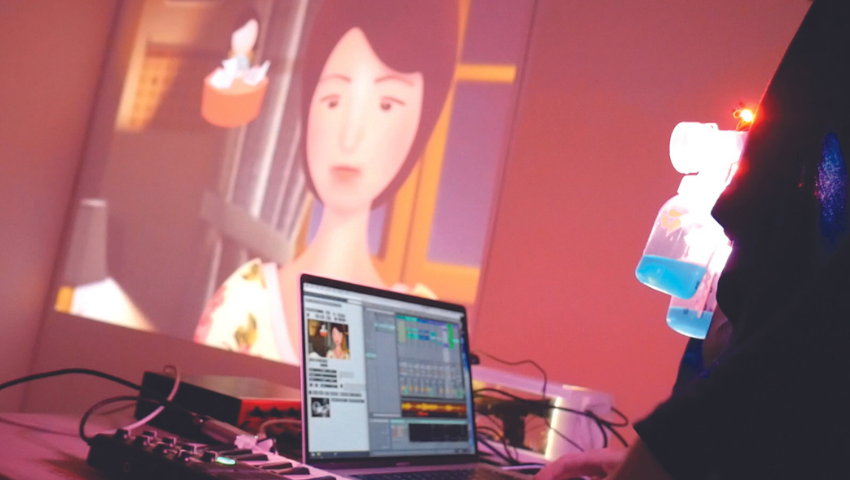“Bad Mother / Good Mother: The Poetics and Politics of the Sounds of Invisible Labor” © 2021 Annina Rüst
SIGGRAPH’s Art Papers program unites researchers and practitioners working at the intersections of art and technology who create projects with a purpose. The SIGGRAPH 2021 Art Papers Best in Show recipient exemplifies purpose-driven art with a message. “Bad Mother / Good Mother: The Poetics and Politics of the Sounds of Invisible Labor” is an audiovisual performance about motherhood, the workplace, and invisible work. We connected with creator Annina Rüst to learn more about the inspiration behind this solo project and how receiving this year’s Best in Show award validates feminism, motherhood, art, and invisible work.
SIGGRAPH: Share some background about “Bad Mother / Good Mother.” What inspired the project?
Annina Rüst (AR): I used a breast pump when my child was a baby. I did it to extract breastmilk while working and to increase supply. During pumping sessions, I spent a lot of time listening to the rhythmic sounds of the pump motor and identified it as a sound resembling a kind of unique, angsty house or techno music. It was clear to me that I needed to turn it into a sound performance.
SIGGRAPH: Tell us about the process of creating “Bad Mother / Good Mother.” How long did it take? What was the biggest challenge you faced?
AR: I created and performed the project myself. It mixed a standard breast pump with a Focusrite audio interface, Ableton Live, and Max 7. I also created a very bright LED pumping bra to make pumping breastmilk ironically glamorous. I performed the project over two years, ending in March 2020, and wrote the paper in the summer of 2020.
As an artist parent with a day job, the main challenge is finding time to make art and write. I think this is a common experience that affects caregivers more intensely. Since caregivers tend to be women, this is something that drives the gender gap in art, research, and many other occupational domains. The COVID-19 pandemic exacerbated this inequity, since the demands on caregivers increased disproportionately as schools and daycare centers closed or limited their hours.
SIGGRAPH: “Bad Mother / Good Mother” is an audiovisual performance. Discuss the role of sound in the project. Why is sound important to the experience?
AR: There is an existing history of music made with household technologies. Most of these compositions do not take into account that the larger share of unpaid, invisible household work — including breastfeeding — is still being done disproportionately by women. So, instead of just making sound with the breast pump and treating it as a sonic curiosity, I am using it to explore perceived ideal and non-ideal motherhood as it relates to women, men, and the workplace. I am doing this by playing the breast pump as a solo instrument, in an arrangement with a beat and samples, as well as processed through filters. I combine this with projections to provide context to the sounds that the audience is hearing.
SIGGRAPH: How do you define “ideal” and “non-ideal” motherhood, and why did you want to touch on these topics in your project?
AR: Societal pressures to be a “good mother” compel women to do inordinate amounts of invisible labor, from which men are largely exempt. Being an “ideal mother” means doing additional work in the home and in other spaces hidden from public view. In the first part of the performance, I am juxtaposing idealized breast pump advertising images with pictures of the non-ideal places, like cramped storage rooms and cars, where people have pumped breastmilk. As far as I am aware, there are very few audio and audiovisual performances that touch on these subjects. I wanted to explore this area since it is an experience shared by many women parents and some men parents.
SIGGRAPH: What do you hope participants take away from reading the results of “Bad Mother / Good Mother”?
AR: Art is subjective. This performance is a subjective view of motherhood and the technologies surrounding it. Some people are inspired by the performance. For others, it is difficult to watch because the topic may hit a little too close to home, or they may not see their experience or viewpoint represented. In the conclusion of the paper, I write that my performance is just one view on motherhood and that there are so many more perspectives on all kinds of (potential) motherhoods and invisible work that still remain to be explored.
SIGGRAPH: Congratulations on receiving the Best in Show award for SIGGRAPH 2021 Art Papers. What does this award mean to you?
AR: I would like to thank Art Papers Chair Daria Tsoupikova as well as the Art Papers peer reviewers. They worked hard to provide feedback so that I could improve the paper. I very much appreciated the deep expertise of the peer reviewers and the chair, as well as the value of the peer review process. I see the award as a testament to the work of this year’s Art Papers committee. As an artist, I primarily produce electronic artworks, not academic papers. Therefore, receiving an award for a paper feels like validation. It also means validation for feminism, motherhood, art, and invisible work, the topics I discuss in the paper.
SIGGRAPH: What are you most looking forward to about the virtual SIGGRAPH 2021 conference?
AR: I am looking forward to exploring the virtual format. My last SIGGRAPH was in 2014 in Vancouver. I was seven months pregnant, and walking had become increasingly painful; 2014 pregnant me would have really loved the virtual format of SIGGRAPH 2021! While the networking interaction is different in the virtual format, for many people — especially caregivers — it might be a relief to be able to participate from home.
SIGGRAPH: What advice do you have for someone looking to submit to Art Papers for a future SIGGRAPH conference?
AR: Submitting to SIGGRAPH Art Papers is a good way to receive feedback on written work from peers with deep expertise in your area. I submitted a paper a few years ago that was rejected by the Art Papers reviewers. I implemented the suggestions from the peer reviewers and submitted it elsewhere, and it was accepted there. Therefore, do not be discouraged if you get rejected — your work is valuable, and the peer review process often provides helpful input to bring a paper to fruition.
Be inspired and wowed by the latest innovations in art, research, technology, and design at SIGGRAPH 2021. Register now to join us online 9–13 August.
 Annina Rüst is an artist-technologist. She creates electronics- and software-based media art. Her works often focus on political issues within tech culture, including gender representation and online privacy. Rüst teaches programming, game development, electronics, data visualization, and digital fabrication at the Harriet L. Wilkes Honors College at Florida Atlantic University where she is an associate professor.
Annina Rüst is an artist-technologist. She creates electronics- and software-based media art. Her works often focus on political issues within tech culture, including gender representation and online privacy. Rüst teaches programming, game development, electronics, data visualization, and digital fabrication at the Harriet L. Wilkes Honors College at Florida Atlantic University where she is an associate professor.



